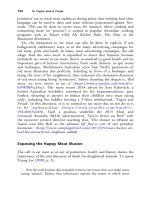The palgrave international handbook of a 22
Bạn đang xem bản rút gọn của tài liệu. Xem và tải ngay bản đầy đủ của tài liệu tại đây (27.92 KB, 1 trang )
Editors’ Introduction
9
Part III focuses on animal abuse that contributes to the decline of species who
live in what we term ‘the wild’. This abuse ranges from small-scale specialised
egg collectors to the large-scale and organised poaching of millions of animals in
the legal and illegal wildlife trade. The three chapters here demonstrate why
animal abuse has found a home in the growing green criminology movement
(Beirne and South 2007; Hall et al. 2016). Environmental destruction poses a
real threat to biodiversity owing to the pollution and elimination of animals’
habitat and the inadequate responses compromised by the complex relationship
between legal and illegal behaviour. Specifically, those responsible for protecting wildlife are able to establish the thin line between legal and illegal acts and to
profit from the harms towards wildlife.
In Part IV the focus shifts to animals used in entertainment. Three of
the four chapters here (‘Animal Racing’, ‘Hunting and Shooting’ and
‘Animal Fighting’) discuss a variety of the changing practices, perceptions
and attitudes associated with the use of animals in sport. They demonstrate the inherent conflict between rights and welfare responses to animal
abuse, suggesting that the latter may have the paradoxical effect of
tempering concern for animals, even as harm to animals remains very
real. This part concludes by challenging the exclusive focus on terrestrial
animals in animal abuse literature and highlights the plight of ‘ornamental’ animals used as entertainment. Although scientific evidence verifies
that fish can feel pain and that they have feelings, this has not improved
their legal standing or reduced their suffering. Rather, the failure to
improve the welfare of fish emphasises a commonplace obstruction in
animal abuse legislation, which exempts the great majority of animals
from receiving protection, through an artfully or neglectfully chosen
phrase in the legal definition of ‘animal’: all sentient beings? invertebrates?
fish? birds? reptiles? ‘vermin’?.
Part V looks at the use of animals in vivisection and scientific research.
The two chapters here exemplify the contradictions in our approach to
animal welfare and rights. The number of animals used in research continues
to rise in large part due to outdated legal requirements, rampant scientific
curiosity and widespread misinformation on the need for animal experiments
rather than the use of non-animal alternatives. This is also often supported by
government funding. The level of duplicity is highlighted in the extensive
and secretive use and re-victimisation of shelter cats and dogs in experimentation. The harms these animals endure in the lab would be considered
criminal in most parts of the developed world if they occurred in any other
social situation or scenario.









